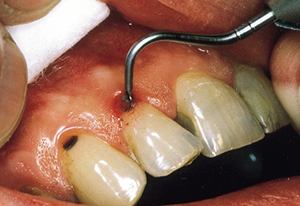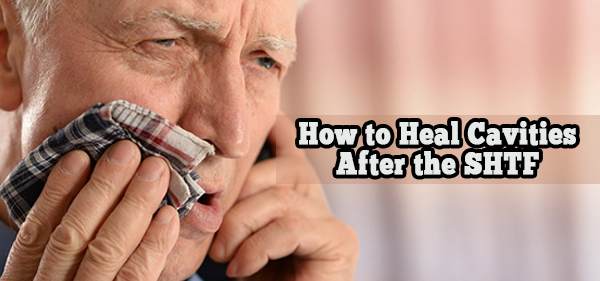Let me make something plain before I start. The best way to heal cavities after the SHTF is to just not get one. Try your best to avoid them, rather than fix them. You can start by cutting down on sugary drinks, not just fizzy ones, but fruit juices too now, and make sure you use fluoride-based toothpaste while you can. The history of dentistry before anesthesia and modern antibiotics was not a pretty one and when the SHTF we will be back there again. In fact I’ll give you a flavor of what it was like to get a toothache back in the day.
 This excerpt was taken from the book, “Teeth, Teeth, Teeth” by James Wynbrandt:
This excerpt was taken from the book, “Teeth, Teeth, Teeth” by James Wynbrandt:
“A friend told me of a man who with two others left the state of Washington for fur trapping in severe remote far northern Canada. They expected to be and were snowed in for a long winter. They had a comfortable cabin and ample supplies but couldn’t and didn’t expect to communicate with others. One suffered a toothache so unbearably painful he shot and killed himself.”
Is this true, I don’t know, but I’m sure many of you reading this, have felt the pain of toothache.
With this in mind, let’s look at the options for managing a cavity when there’s no anesthesia or dentists to help.
Related: Dental Care after SHTF
Basic Steps to Filling a Cavity
NOTE: The sooner you can tackle the cavity, the easier it will be and the less chance of infection.
- Inspect the cavity for decay, noting the extent
- Give the patent some form of anesthesia (see below for natural options if you don’t have any stock of pain killer available)
- Clean the cavity and remove any decay using a tooth pick tool
- Dry the cavity – it is very important the cavity is dry as water can affect the cement
- Prepare a cavity cement (see below for alternatives if you don’t have any dental cement)
- Fill the cavity with the cement
NOTE: Keep everything sterile – your tools and yourself.
Ideas for Things to Stock Up On Before the SHTF
It is a really good idea to stock up on the following items in readiness for toothache when the SHTF:
- Fluoride toothpaste
- DIY dentistry kits (available from pharmacies)
- Glass ionomer dental cement or Zinc Oxide and Eugenol liquid
- Pain relief gel (available from pharmacies)
- Dentist tool kits, which include, tweezers, mirror, pick tool (available online)
Getting at the Source of the Trouble: The Tools of the Trade
The problem with dentistry is that you’re dealing with a confined space. Getting at a tooth, especially the molars near the back of the mouth. You therefore need to have the right tools for the job. The first job is that a cavity needs to be cleaned; less so if the cavity is formed by a pre-existing amalgam falling out. The tools you need to find and clean a cavity are:
- A small mirror that can fit in the mouth to let you see the cavity
- A tool that is angled and has a sharp edge so that you can get at the cavity and that can help clean it.
In modern times, dentists use an electrically powered drill to clean out the decay. The likelihood of you having power after the SHTF is pretty low (unless you have a home grown generator). So lets assume you don’t have any electricity – like in a total EMP Blackout. In this case you need to locate the cavity. Once you find it, you have to be careful to clear all of the debris and especially the decay out of the cavity. This will be done manually and can be a painful process as there is a high likelihood of hitting the tooth nerve. Having experienced this myself, I can tell you it really is horrendous pain. However, if you leave any decay behind, the decay will continue once you fill the cavity and cause even more problems and pain.
An Experiment in Painless Decay Removal

There has been some research into removal of decay without need for a drill. The research concentrated on the use of a mix of amino acids and sodium hypochlorite. In clinical trials, the mixture was shown to remove decay over a 5-15 minute period and is painless. You can read the full transcript on the method here in the journal, Nature.
It isn’t easy to buy the gel online, but in the next few years it may become more widely available.
Pain Relief and Antiseptic
If you haven’t stocked up on pain relief or antiseptic then you’ll need to find some natural alternative. Over the millennia, humans have experimented with pain relief for toothache. The Greek physician, Galen, born in 130AD was reported to use pickled root of chrysanthemum, which was effective but also caused surrounding teeth to become loosened. In 13th century Europe, ‘sleep sponges’ were used which consisted of sponges soaked in concentrated hemlock, opium, henbane and lettuce seeds – I’m sure that would do the trick…
Some natural pain relief and antiseptic that is a little easier to get hold of than opium are:
- I have had clove oil applied by a professional dentist myself to an open wound where a wisdom tooth was removed and it did help. To make up some clove oil, take two cloves and grind them to a powder. Add a little oil and create a mixture, which is placed on and around the infected tooth.
- Warm, salty water: A simple but very effective way to kill off bacteria. Just swish the salty solution around your mouth, focusing on the infected area. This will kill bacteria and help relive the pain of the cavity before attending to it.
- Powdered ginger and cayenne pepper: Make a paste of these two ingredients with a little water and place o the infected tooth. Helps with toothache.
- Ice: Ice, if you can get hold of some, is a great pain relief method as it simply numbs the surrounding area.
- Natural salicylates: These are the derivative to modern aspirin and found in various leaves, such as birch leaves and white willow bark – chew on the leaves or the bark to relieve pain.
Filling the Cavity
If you haven’t stocked up on cavity cement before the SHTF then you’ll need to find some alternatives. However, do try and keep a good supply of the glass ionomer available as it is an effective cavity filler and really easy to use – you don’t need UV light to set it, for example.
Using Cavity Cement
 Once you’ve cleaned the cavity and dried it out, pace a little cotton wool or tissue in the cavity to keep it dry.
Once you’ve cleaned the cavity and dried it out, pace a little cotton wool or tissue in the cavity to keep it dry.
You can make cavity cement from Zinc Oxide powder and Eugenol liquid. Eugenol liquid can be irritating to the gums, so be careful with it. Mix the zinc oxide powder ad a few drop of the Eugenol liquid together on a hard flat surface, like a ceramic tile. It works best when it is thick and not sticky. You can tell if it isn’t ready by rolling it between your fingers – if it sticks, its not ready, you can add a little more zinc oxide to get it to the point of readiness.
Once its ready, pull the cotton wool or tissue out of the cavity and fill the cavity with the cement. Smooth it using something like a wood tooth pick or similar. Remove any cement that spills outside the cavity before it sets using your dentist tools. Try to smooth down the surface of the cement as much as possible, ensuring the whole cavity is filled. My dentist will make me bite down on some paper to see if there are any rough edges left over.
You should not eat or drink anything for about 1-2 hours after the filling is done to give it time to set.
Final Note: Oil Pulling
There is a procedure known as ‘oil pulling’ that purports to be a cure for cavities. I can’t find any real evidence that this method works, but I can’t see any real harm in using it either. The method suggest you use an oil, like coconut oil, which you then swish around your mouth for 20 minutes each morning before eating food. Apparently the oil ‘remove impurities’ and can remove or reduce the decay in a cavity effectively fixing the cavity.
You may also like:
Burdock: The Annoying Weed That Can Save Your Life
H2O Dynamo – The Awesome Device That Turns Air Into Water (Video)
This Common Driveway Weed is One of Nature’s Most Powerful Survival Plants













My daughter healed three cavities by pulling coconut oil.
You can try a tincture of Black Walnut Hull. the green hull when they first fall off the tree. This is full of juglone. It does effectively work to relieve the pain. And from what I have read, it is supposed to cure a cavity. Although, I have not been in a position to try this. I know it does relieve toothache pain almost immediately. Good luck.
Recommending fluoride toothpaste means you haven’t done your due diligence. That’s the American Dental Association self-serving position, not reality. Please reconsider spreading that propaganda. Thanks.
I’m glad someone else is aware of reality! Thanks for the good content!
Don’t tell people to use fluoride. That actually makes things worse. You better do some research on that. You should use an all natural and organic toothpaste. Or use a mixture of baking soda and french salt.
I don’t think you fully understand the dangers in using fluoride. I have an under performing thyroid. Fluoride is an anti-thyroid drug. Many people have this and do not know it. Fluoride can SHUT YOUR THYROID DOWN. Do not recommend it indiscriminately.
how about a battery powered Dremel tool w/ a dental grinding tip? Does anyone sell used or new dental tools? They throw those little mirrors away all the time.
Our dentist who has seen our 5 children grow up, has given us old probes and such as he knows my husband is a mr. fix-it. So just ask your Dentist, just be sure you Always sterilize what you use before & after.
CLOVE OIL (APPLIED TO A FINGER FIRST) AND APPLIED THREE TIMES A DAY WILL KILL A TOOTHACHE. IT WILL EVEN REVERSE AN ABCESSED TOOTH WHOSE INFECTION HAS REACHED THE UNDERLYING BONE. IT IS AN ESSENTIAL OIL ANTIOXIDANT AND WALKS RIGHT THROUGH GUM TISSUE. BE CAREFUL TO APPLY ONLY TO AFFECTED AREA. WILL FEEL WARM,BUT DO NOT RINSE FOR ABOUT A MINUTE. IT WILL BE YOUR GREATEST ALLY AND WILL SAVE YOUR LIFE IF YOU SIMPLY LEARN TO USE IT!
Your endorsement of flouride greatly erodes any idea of taking you seriously, pls investigate that and re-post your article
I was stationed with a guy who had the ugliest teeth I had ever seen. They were a mottled greenish color. One day I screwed up my courage and asked him about it. He laughed and said, “They sure are ugly, aren’t they? But you know what? I don’t have a cavity in my mouth and nobody in my town does either. Our city water has a high fluoride content.”
You can make of that what you will. This was way before there were any fluoride toothpastes on the market. Ipana was one of the more popular brands at the time. How many of you are old enough to remember Ipana toothpaste?
The greenish tinge is “fluorosis”. The fluoride increases the density of the teeth, but this really makes the teeth more brittle and less capable of absorbing the impact of daily chewing. Anyone with whith spots on their teeth has dental fluorsis. The short term “benefits” of this are not worth the long term systemic health implications. Fluoride is a highly active neurotoxin. Sodium fluoride is not something one wants anywhere near their mucous membranes…
Brush a Brush Brush with my new Imana
spell check sigh Brusha, Brusha, Brusha with my new Ipana
Fluoride is a mineral that occurs naturally in water. Fluoride toothpaste and mouth rinses are safe if you do not swallow these substances. I believe Susan Morrow is spot on with this article and some very good recommendations. Serious toothache can be as debilitating as a broken leg. They can kill you if left untreated, as in infections into jaw and eventually into the brain. Not a matter to be taken lightly.
I have heard that taking the supplement MK-7 along with calcium (derived from natural sources of course, not chemical compounds) helps to rebuild the tooth enamel. I have 3 small cavities and I took these religiously for 8 months and they seemed to get better towards the end. I took twice the daily recommended dose of MK-7, and I already took more calcium because we have Osteoporosis in my family. I couldn’t afford supplements for a 6 months and I’ve since had them get a little worse again. Thanks for reminding me to make an effort to get them again!
“fluoride-based toothpaste while you can..”
No thanks
Agreed…
Allspice – Toothache: Pack the tooth in allspice. Re-apply as necessary.